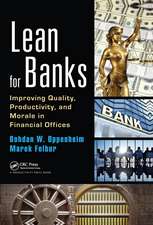Wicking in Porous Materials: Traditional and Modern Modeling Approaches
Editat de Reza Masoodi, Krishna M. Pillaien Limba Engleză Hardback – 26 oct 2012
Top experts in the field reveal the secrets of their wicking models. The chapters cover the following topics:
- Wetting and wettability
- Darcy’s law for single- and multi-phase flows
- Traditional capillary models, such as the Washburn-equation based approaches
- Unsaturated-flow based methodologies (Richard’s Equation)
- Sharp-front (plug-flow) type approaches using Darcy’s law
- Pore network models for wicking after including various micro-scale fluid-flow phenomena
- Studying the effect of evaporation on wicking using pore network models
- Fractal-based methods
- Modeling methods based on mixture theory
- Lattice-Boltzmann method for modeling wicking in small scales
- Modeling wicking in swelling and non-rigid porous media
| Toate formatele și edițiile | Preț | Express |
|---|---|---|
| Paperback (1) | 581.20 lei 6-8 săpt. | |
| CRC Press – 29 mar 2017 | 581.20 lei 6-8 săpt. | |
| Hardback (1) | 1389.36 lei 6-8 săpt. | |
| CRC Press – 26 oct 2012 | 1389.36 lei 6-8 săpt. |
Preț: 1389.36 lei
Preț vechi: 1694.34 lei
-18% Nou
Puncte Express: 2084
Preț estimativ în valută:
265.89€ • 276.57$ • 219.51£
265.89€ • 276.57$ • 219.51£
Carte tipărită la comandă
Livrare economică 12-26 aprilie
Preluare comenzi: 021 569.72.76
Specificații
ISBN-13: 9781439874325
ISBN-10: 1439874328
Pagini: 380
Ilustrații: 132 b/w images, 5 tables and 423 Equations, 1 in text box
Dimensiuni: 156 x 234 x 25 mm
Greutate: 0.68 kg
Ediția:New.
Editura: CRC Press
Colecția CRC Press
Locul publicării:Boca Raton, United States
ISBN-10: 1439874328
Pagini: 380
Ilustrații: 132 b/w images, 5 tables and 423 Equations, 1 in text box
Dimensiuni: 156 x 234 x 25 mm
Greutate: 0.68 kg
Ediția:New.
Editura: CRC Press
Colecția CRC Press
Locul publicării:Boca Raton, United States
Public țintă
Professional Practice & DevelopmentCuprins
Traditional Theories of Wicking: Capillary Models. Wicking in Absorbent Swelling Porous Materials. Evaporation and Wicking. Pore-Network Modeling of Wicking; A Two-Phase Flow Approach. A Fractal Based Approach to Model Wicking. Simulating Fluid Wicking into Porous Media with the Lattice Boltzmann Method.
Notă biografică
Dr. Krishna M. Pillai is Associate Professor at University of Wisconsin-Milwaukee.
Dr. Reza Masoodi is a research associate at the Laboratory for Flow and Transport Studies in Porous Media at University of Wisconsin-Milwaukee.
Dr. Reza Masoodi is a research associate at the Laboratory for Flow and Transport Studies in Porous Media at University of Wisconsin-Milwaukee.
Descriere
This reference offers information on the current science and recent advances of wicking in porous materials. The book describes various modeling approaches, traditional and modern, but maintains an emphasis on the modern methodologies. A host of internationally recognized scientists and researchers contribute chapters to this book to describe the physics of wicking and the different approaches available for modeling wicking. Chapters cover capillary models (such as the Lucas-Washburn equation), sharp-front single phase-flow models, two-phase flow models (such as the Richard equation), network models, a Lattice-Boltzmann model, a mixture-theory based model, and a fractal-based modeling approach. The authors emphasize experimental validation of theoretical and numerical predictions along with experimental measurement of the necessary parameters.

















